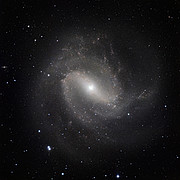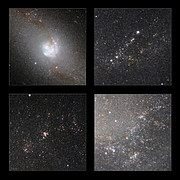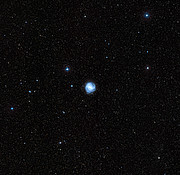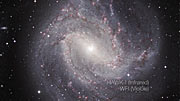Pressemitteilung
Neue Ansichten einer altbekannten Spiralgalaxie
19. Mai 2010
München (Europäische Südsternwarte): Die ESO veröffentlicht heute ein wunderschönes Bild der nahegelegenen Galaxie Messier 83, das mit der Kamera HAWK-I am Very Large Telescope (VLT) auf dem Paranal Observatorium der ESO in Chile aufgenommen wurde. Die eindrucksvolle Darstellung der Galaxie im Infrarotlicht demonstriert das Leistungsvermögen der Kamera: Es handelt sich um eine der schärfsten und detailreichsten Aufnahmen von Messier 83, die jemals vom Erdboden aus aufgenommen wurden.
Die Galaxie Messier 83 (eso0825) befindet sich von der Erde aus gesehen in einer Entfernung von etwa 15 Millionen Lichtjahren im Sternbild Hydra (die Wasserschlange). Mit rund 40.000 Lichtjahren Durchmesser ist sie nur 40 Prozent so groß wie die Milchstraße, ist unsererHeimatgalaxie aber in mehr als einer Hinsicht sehr ähnlich: Sie hat die Form einer Spirale und weist in ihrem Zentrum einen „Balken“ aus Sternen auf. Unter Astronomen ist Messier 83 insbesondere aufgrund des gehäuften Auftretens von Supernovae bekannt: Im Laufe der letzten 100 Jahre fanden in dieser Galaxie sechs solcher gewaltigen Explosionen statt, mit denen das Leben massereicher Sterne zuende geht - ein Rekordwert, der nur von einer einzigen anderen Galaxie übertroffen wird. Aber auch wenn dort gerade keine Supernova-Explosion leuchtett ist Messier 83 eine der hellsten Galaxien in unserer kosmischen Nachbarschaft und schon mit einem Fernglas beobachtbar.
Mit der leistungsstarken Kamera HAWK-I [1] am Very Large Telescope (VLT) der ESO wurde Messier 83 nun im Infrarotbereich des elektromagnetischen Spektrums beobachtet. Im Infrarotlicht wird ein Großteil des Staubschleiers, der viele Details von Messier 83 vor uns verbirgt, durchsichtig. Andererseits ist das hell erleuchtete Gas, das heiße junge Sterne in den Spiralarmen umgibt,im Infrarotlicht weniger auffällig. Insgesamt ergibt sich ein Bild, auf dem die Struktur der Galaxie und die Unmengen von Sternen, aus denen sie besteht, besonders gut erkennbar sind. Dieser Scharfblick ist wichtig für Astronomen, die Anhäufungen junger Sternen untersuchen möchten, insbesondere solche Sternhaufen, die in den staubigen Bereichen der Galaxie verborgen sind – eines der Hauptziele der HAWK-I-Beobachtungen [2]. Im Vergleich zu früheren Aufnahmen enthüllt der scharfe Blick von HAWK-I innerhalb der Galaxie eine deutlich größere Anzahl von Sternen.
Die Kombination der riesigen Spiegelfläche des VLT und der herausragenden Beobachtungsbedingungen am Paranal-Observatorium der ESO mit dem großen Gesichtsfeld und der hohen Empfindlichkeit von HAWK-I machen das Instrument zu einer der leistungsstärksten Nahinfrarotkameras der Welt. Seit es 2007 in Betrieb genommen wurde (eso0736), stehen die Astronomen Schlange für die Möglichkeit, HAWK-I nutzen zu können und damit die besten bodengebundenen Infrarotaufnahmen des Nachthimmels zu gewinnen.
Endnoten
[1] Das Akronym HAWK-I steht für High-Acuity Wide-field K-band Imager (etwa “Kamera für das [infrarote] K-Band mit großem Gesichtsfeld und hoher Schärfeleistung”), Technische Details der Kamera sind in einer früheren Pressemitteilung dargestellt (eso0736, auf Englisch).
[2] Die Daten, auf denen dieses Bild basiert, wurden von einem Team eingeworben, das von Mark Gieles (University of Cambridge) und Yuri Beletsky (ESO) geleitet wurde. Mischa Schirmer (Universität Bonn) hat die komplizierte Bildbearbeitung übernommen.
Weitere Informationen
Die Europäische Südsternwarte ESO (European Southern Observatory) ist die führende europäische Organisation für astronomische Forschung und das wissenschaftlich produktivste Observatorium der Welt. Getragen wird die Organisation durch ihre 14 Mitgliedsländer: Belgien, Dänemark, Deutschland, Finnland, Frankreich, Italien, die Niederlande, Österreich, Portugal, Spanien, Schweden, die Schweiz, die Tschechische Republik und das Vereinigte Königreich. Die ESO ermöglicht astronomische Spitzenforschung, indem sie leistungsfähige bodengebundene Teleskope entwirft, konstruiert und betreibt. Auch bei der Förderung internationaler Zusammenarbeit auf dem Gebiet der Astronomie spielt die Organisation eine maßgebliche Rolle. Die ESO betreibt drei weltweit einzigartige Beobachtungsstandorte in Nordchile: La Silla, Paranal und Chajnantor. Auf Paranal betreibt die ESO mit dem Very Large Telescope (VLT) das weltweit leistungsfähigste Observatorium für Beobachtungen im Bereich des sichtbaren Lichts, sowie VISTA, das größte Durchmusterungsteleskop der Welt. Die ESO ist der europäische Partner für den Aufbau des Antennenfelds ALMA, das größte astronomische Projekt überhaupt. Derzeit entwickelt die ESO das European Extremely Large Telescope (E-ELT) für Beobachtungen im Bereich des sichtbaren und Infrarotlichts, mit 42 Metern Spiegeldurchmesser ein Großteleskop der Extraklasse.
Kontaktinformationen
Richard Hook
ESO
Garching, Germany
Tel: +49 89 3200 6655
E-Mail: rhook@eso.org
Markus Nielbock (Pressekontakt Deutschland)
ESO Science Outreach Network
und Haus der Astronomie
Heidelberg, Deutschland
Tel: +49 6221 528-134
E-Mail: eson-germany@eso.org
Über die Pressemitteilung
| Pressemitteilung Nr.: | eso1020de |
| Name: | M 83 |
| Typ: | Local Universe : Galaxy : Type : Spiral |
| Facility: | Very Large Telescope |
| Instruments: | HAWK-I |
Our use of Cookies
We use cookies that are essential for accessing our websites and using our services. We also use cookies to analyse, measure and improve our websites’ performance, to enable content sharing via social media and to display media content hosted on third-party platforms.
ESO Cookies Policy
The European Organisation for Astronomical Research in the Southern Hemisphere (ESO) is the pre-eminent intergovernmental science and technology organisation in astronomy. It carries out an ambitious programme focused on the design, construction and operation of powerful ground-based observing facilities for astronomy.
This Cookies Policy is intended to provide clarity by outlining the cookies used on the ESO public websites, their functions, the options you have for controlling them, and the ways you can contact us for additional details.
What are cookies?
Cookies are small pieces of data stored on your device by websites you visit. They serve various purposes, such as remembering login credentials and preferences and enhance your browsing experience.
Categories of cookies we use
Essential cookies (always active): These cookies are strictly necessary for the proper functioning of our website. Without these cookies, the website cannot operate correctly, and certain services, such as logging in or accessing secure areas, may not be available; because they are essential for the website’s operation, they cannot be disabled.
Functional Cookies: These cookies enhance your browsing experience by enabling additional features and personalization, such as remembering your preferences and settings. While not strictly necessary for the website to function, they improve usability and convenience; these cookies are only placed if you provide your consent.
Analytics cookies: These cookies collect information about how visitors interact with our website, such as which pages are visited most often and how users navigate the site. This data helps us improve website performance, optimize content, and enhance the user experience; these cookies are only placed if you provide your consent. We use the following analytics cookies.
Matomo Cookies:
This website uses Matomo (formerly Piwik), an open source software which enables the statistical analysis of website visits. Matomo uses cookies (text files) which are saved on your computer and which allow us to analyze how you use our website. The website user information generated by the cookies will only be saved on the servers of our IT Department. We use this information to analyze www.eso.org visits and to prepare reports on website activities. These data will not be disclosed to third parties.
On behalf of ESO, Matomo will use this information for the purpose of evaluating your use of the website, compiling reports on website activity and providing other services relating to website activity and internet usage.
Matomo cookies settings:
Additional Third-party cookies on ESO websites: some of our pages display content from external providers, e.g. YouTube.
Such third-party services are outside of ESO control and may, at any time, change their terms of service, use of cookies, etc.
YouTube: Some videos on the ESO website are embedded from ESO’s official YouTube channel. We have enabled YouTube’s privacy-enhanced mode, meaning that no cookies are set unless the user actively clicks on the video to play it. Additionally, in this mode, YouTube does not store any personally identifiable cookie data for embedded video playbacks. For more details, please refer to YouTube’s embedding videos information page.
Cookies can also be classified based on the following elements.
Regarding the domain, there are:
- First-party cookies, set by the website you are currently visiting. They are stored by the same domain that you are browsing and are used to enhance your experience on that site;
- Third-party cookies, set by a domain other than the one you are currently visiting.
As for their duration, cookies can be:
- Browser-session cookies, which are deleted when the user closes the browser;
- Stored cookies, which stay on the user's device for a predetermined period of time.
How to manage cookies
Cookie settings: You can modify your cookie choices for the ESO webpages at any time by clicking on the link Cookie settings at the bottom of any page.
In your browser: If you wish to delete cookies or instruct your browser to delete or block cookies by default, please visit the help pages of your browser:
Please be aware that if you delete or decline cookies, certain functionalities of our website may be not be available and your browsing experience may be affected.
You can set most browsers to prevent any cookies being placed on your device, but you may then have to manually adjust some preferences every time you visit a site/page. And some services and functionalities may not work properly at all (e.g. profile logging-in, shop check out).
Updates to the ESO Cookies Policy
The ESO Cookies Policy may be subject to future updates, which will be made available on this page.
Additional information
For any queries related to cookies, please contact: pdprATesoDOTorg.
As ESO public webpages are managed by our Department of Communication, your questions will be dealt with the support of the said Department.







